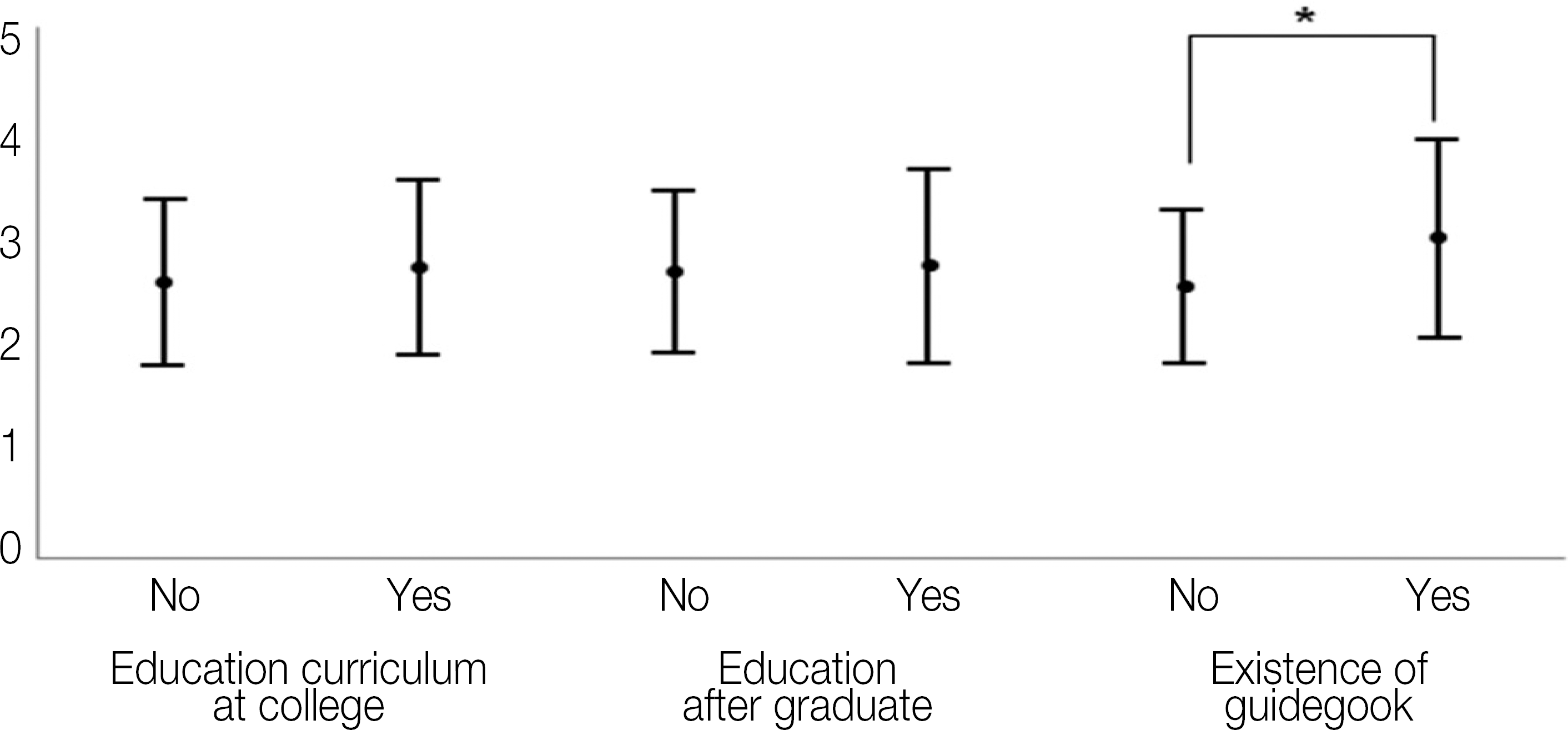Abstract
Purpose
The aim of this study was to assess the degree of awareness and actual practice of dental practitioners regarding infection control during prosthodontic treatment.
Materials and methods
Study participants were composed of dentists, dental hygienists, dental technicians working at dental university hospital, general hospital, dental hospital and dental clinics in Daejeon, Korea (n=126). The questionnaires included the data on general characteristics, education, awareness and practice of infection control procedures during prosthodontic treatment through personal self-administration survey. Awareness and practice were measured by Likert scale ranging from 1 to 5. Statistical analysis was done by one-way ANOVA. Influence of awareness on practice was estimated by regression analysis.
Results
27.7% of the respondents answered that the infection control education regarding prosthodontic treatment is insufficient. The mean value of awareness and practice of infection control during the prosthodontic treatment were 2.72 ± 0.80, 1.58 ± 0.88, respectively. The mean value of practice who answered that had education curriculum at college was 1.62 ± 0.9, and 1.31 ± 0.49 who did not. The mean value of awareness who equipped guideline was 3.01 ± 0.9, and 2.56 ± 0.70 who did not.
Conclusion
1. The respondents who received the infection control education by college curriculum showed higher degree of practice than the respondents who did not. 2. The respondents who have appropriate infection control guidebook in their workplace showed higher degree of awareness than the respondents who did not. 3. There was a correlation between the awareness and practice of infection control during prosthodontic treatment; the degree of awareness becomes higher, so does the degree of practice. 4. During the prosthodontic treatment, the degree of practice was lower than the degree of awareness on infection control.
Go to : 
REFERENCES
1. Statistics Korea. 2014 Statistics on the aged. Available at: ". http://kosis.kr/up-s/ups_01List01.jsp?grp_no=&pubcode=KO&type=F". Accessed October 2. 2014.
2. Meskin L, Berg R. Impact of older adults on private dental practices, 1988-1998. J Am Dent Assoc. 2000; 131:1188–95.

3. Shaw FE Jr, Barrett CL, Hamm R, Peare RB, Coleman PJ, Hadler SC, Fields HA, Maynard JE. Lethal outbreak of hepati-tis B in a dental practice. JAMA. 1986; 255:3260–4.

4. Robinson P, Challacombe S. Transmission of HIV in a dental practice the facts. Br Dent J. 1993; 175:383–4.
5. Oh SK. Recommended infection-control practices for dentistry. J Korea Dent Assoc. 1993; 301:409–16.
6. Agostinho AM, Miyoshi PR, Gnoatto N, Paranhos Hde F, Figueiredo LC, Salvador SL. Cross-contamination in the dental laboratory through the polishing procedure of complete dentures. Braz Dent J. 2004; 15:138–43.
8. ADA Council on Dental Therapeutics; Council on Prosthetic Services and Dental Laboratory Relation. Guidelines for infection control in the dental office and the commercial dental laboratory. J Am Dent Assoc. 1985; 110:969–72.
9. Kohn WG, Harte JA, Malvitz DM, Collins AS, Cleveland JL, Eklund KJ. Centers for disease control and prevention. Guidelines for infection control in dental health care settings 2003. J Am Dent Assoc. 2004; 135:33–47.
10. King TB, Muzzin KB. A national survey of dental hygienists' infection control attitudes and practices. J Dent Hyg. 2005; 79:8.
11. Allen IE, Seaman CA. Likert scales and data analyses. Quality Progress. 2007; 40:64–5.
12. Korean Dental Association. Infection control procedure in dental office. Available at: ". http://www.kda.or.kr/KDAShare/kdam-ba_ebook/ecatalog.html. " Dir Accessed October 2. 2014.
13. ADA Council on Scientific Affairs and ADA Council on Dental Practice. Infection control recommendations for the dental office and the dental laboratory. J Am Dent Assoc. 1996; 127:672–80.
14. Leung RL, Schonfeld SE. Gypsum casts as a potential source of microbial cross-contamination. J Prosthet Dent. 1983; 49:210–1.

15. Kotsiomiti E, Tzialla A, Hatjivasiliou K. Accuracy and stability of impression materials subjected to chemical disinfection - a literature review. J Oral Rehabil. 2008; 35:291–9.

16. Glass RT, Bullard JW, Hadley CS, Mix EW, Conrad RS. Partial spectrum of microorganisms found in dentures and possible disease implications. J Am Osteopath Assoc. 2001; 101:92–4.
17. Salvia AC, Matilde Fdos S, Rosa FC, Kimpara ET, Jorge AO, Balducci I, Koga-Ito CY. Disinfection protocols to prevent cross-contamination between dental offices and prosthetic lab-oratories. J Infect Public Health. 2013; 6:377–82.

Go to : 
 | Fig. 1.Answers regarding infection control education. (A) Education curriculum at college, (B) Education after graduate, (C) Equipment of guidebook. |
 | Fig. 2.Awareness of infection control during prosthodontic treatment depending on education (∗: Statistically significant with P<.01). |
Table 1.
Major composition & contents of questionnaire
Table 2.
Sociodemographic data of respondents
Table 3.
Awareness and practice of infection control during prosthodontic treatment
Table 4.
Comparison of awareness and practice depending on the occupation of respondents
| Variables | Awareness | Practice | ||
|---|---|---|---|---|
| Mean | SD | Mean | SD | |
| Dentist | 2.82 | 0.78 | 1.43 | 0.69 |
| Dental hygienist | 2.64 | 0.77 | 1.55 | 0.90 |
| Dental technician | 2.78 | 0.92 | 1.80 | 1.03 |
| Overall | 2.72 | 0.80 | 1.58 | 0.88 |
| P value | 0.571 | 0.299 | ||
Table 5.
Influence of awareness on practice estimated by regression analysis
| Unstandardized coefficients | Standardized coefficients | t | significant probability | ||
|---|---|---|---|---|---|
| B | Standard error | ® | |||
| Awareness | 0.732 | 0.076 | 0.667 | 9.682 | .000∗∗∗ |




 PDF
PDF ePub
ePub Citation
Citation Print
Print


 XML Download
XML Download